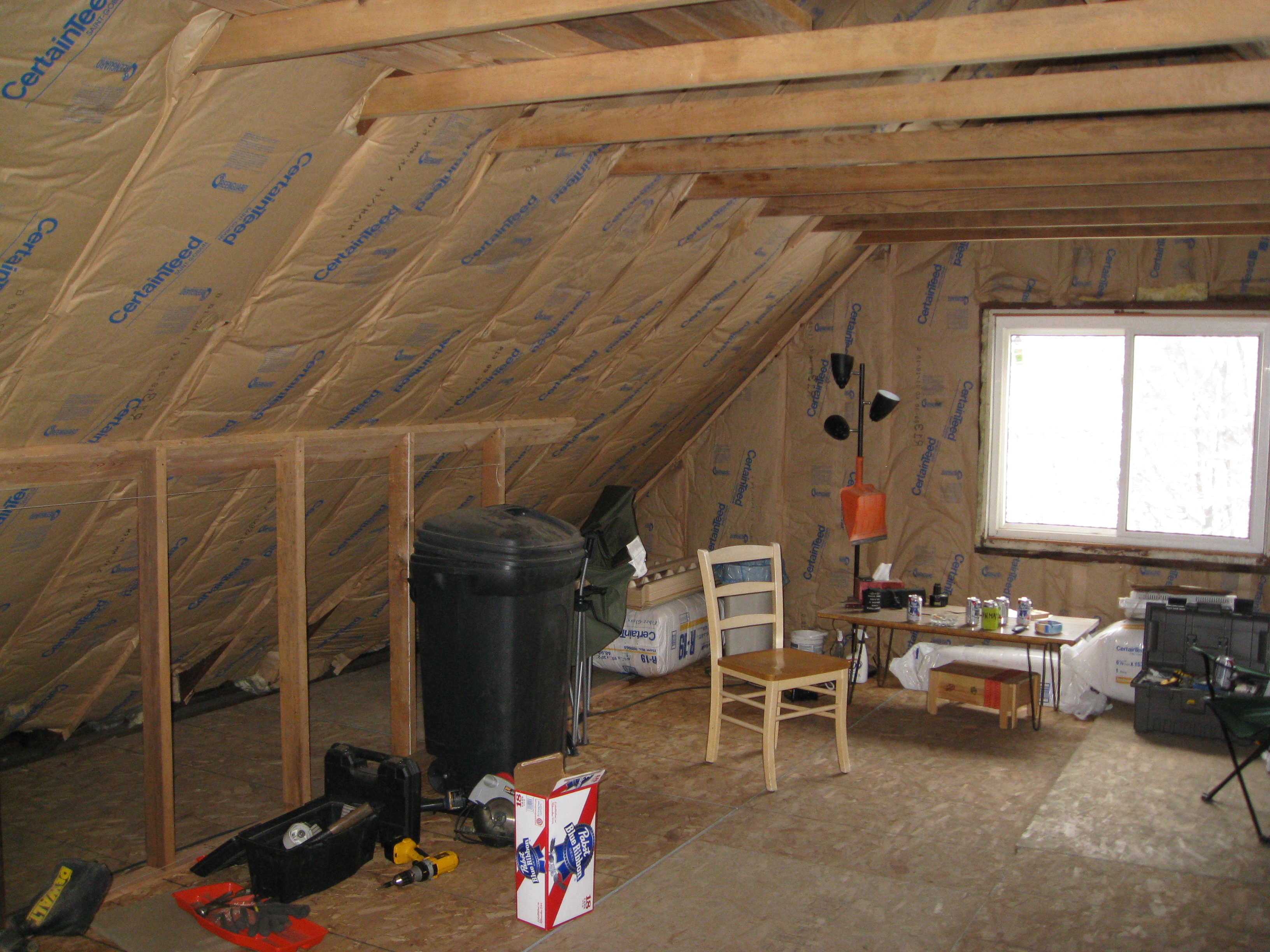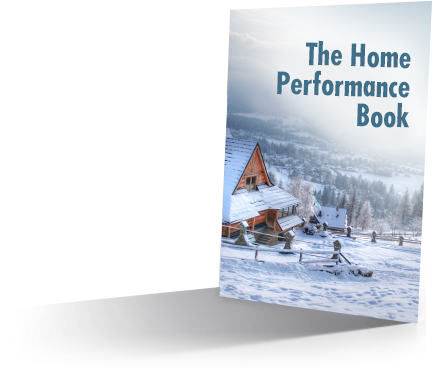One Knob Pt 2 of 4 Low Hanging Fruit Fallacy

This time, let’s discuss something we’ve found about job size and how low hanging fruit seldom leads to delivering remarkable results. It may seem tangential, but this has a substantial effect on what program design should actually be.
First, a definition. Energy efficiency programs (programs) refers to any utility or state program that offers homeowners a rebate, incentive, or inexpensive financing to make energy efficient upgrades in their homes.
We Don’t Need No Stinking Programs
Also, it’s important to note that Comprehensive Home Performance DOES NOT require programs. Energy Smart is proving that right now. We are selling $15-$40k jobs involving both shell and HVAC measures with no program & no special financing, in a low housing and utility cost area. Like a bumblebee, a physicist didn’t tell us us we couldn’t fly so we just did.
But Programs Can Help
Programs could help accelerate market transformation. Rather than dictating details and constraining trades, properly designed and implemented incentive programs can help start and accelerate markets.
Low Hanging Fruit Is Poisoned
A major current problem with program design is that it encourages chasing low hanging fruit. Programs tend to think individual measures save energy predictably and repeatably, so low hanging fruit is a good strategy. They do not. Every situation is unique, and bringing things into balance is different every time. We think the best opportunity is the first, “easy pickings” opportunities.
What is required to truly achieve Home Performance and energy savings is deeper. We have to get pretty good control over heat, air, and moisture flows within a home. No single measure can do this. It takes a mixture of well thought out improvements to get there. In our experience, making a few small changes often has disappointing results or unintended consquences.
For now, this concept is largely anecdotal. But it meshes with what Lew Harriman, Rick Chitwood, Mike MacFarland, Dan Perunko and Gavin Healy have found and reported in Measured Home Performance. MacFarland has so much confidence in his energy predictions that he guarantees total energy bills or he pays the difference. He can predict monthly bills within a few bucks a month. His jobs aren’t small, though, the illustrations will show why. It also jives with John Proctor’s study of 4 homes in California. So please bear with the rather conceptual ideas here, in time One Knob will provide data to compare this hypothesis with.
We’ve come up with a way of visualizing Low Hanging Fruit Thinking vs. Comprehensive Home Performance thinking.
Let’s look at some illustrations. The X axis shows upgrade measures, investments, or money spent. Attic air sealing, attic insulation, a furnace, and air conditioner would all be things that would go on there. The Y axis is results. It could be energy savings, or it could be solved client problems.
Here is a curve showing how people THINK energy savings opportunity looks, a game of quickly diminishing returns. This is intuitively how it seems like it should work. A few of the changes should have the largest effect.
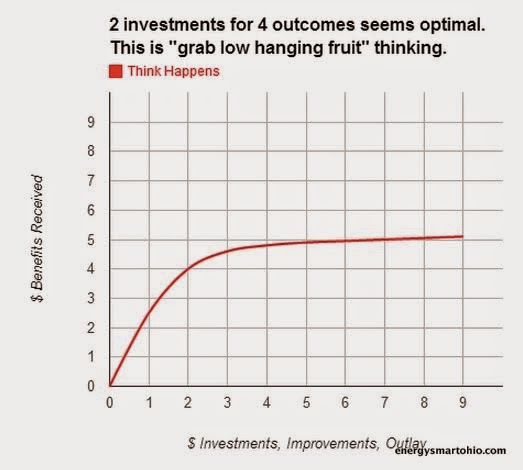
Snow Tire Thinking
Would you buy just one snow tire? Two might help, but most would agree four is really best. The benefit of one is basically zilch, and actually is likely to hurt you when you wreck the car. The real benefit occurs when you reach four. Then you have true control over the car’s movement, just as Home Performance (HP) aims to control heat, air, and moisture movement within a home.
In buildings serious energy savings occurs when out of balance systems are brought into balance. The whole building is the system, not just the insulation or furnace. This doesn’t always require spending more money, but it requires thinking systemically rather than prescriptively. So the above graph is not as true as we might think.
Here is how comprehensive energy efficiency success/opportunity curve ACTUALLY looks. Returns don’t start to occur until you get deep enough to start correcting imbalances:
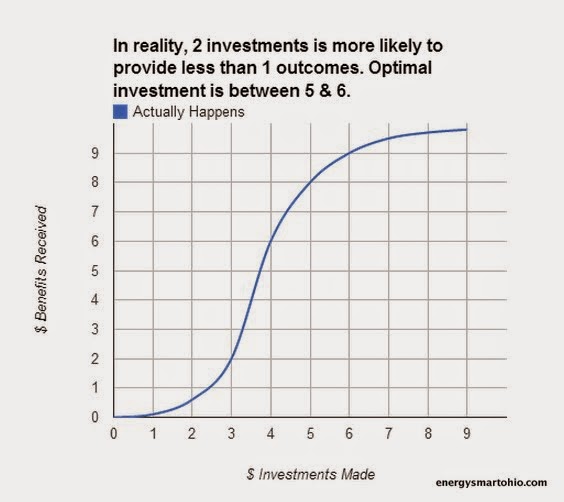
In Systems Thinking, Everything Is Interconnected
Energy Efficiency requires design specific to the situation. Everything has to work together, solving specific and unique problems. The more things are brought into balance, the greater efficiency is realized.1
Another way to look at it is like losing weight and getting healthy. If you watch what you eat two days a week, but pig out the rest of the time and don’t exercise, can you expect results? Of course not. Truly improving health requires a tailored mix of diet and exercise. Training to run a half marathon would likely land in the middle of the curve, where 4 investments leads to 6 benefits.
Unfortunately people don’t realize that when you just do one thing and results fail it is a failure of systems design. You can’t replace one snow tire, it is part of a system. You can’t just diet 2 days a week, there must be a system of diet and exercise to see results.
Interaction Examples
In a home, if you just air seal the attic, you will likely drive up energy costs because the warm attic is no longer a buffer. Just insulate and mold is likely when the temperature gets low enough for condensation and moisture comes from inside the house. Put in an efficient furnace in a crappy building envelope, and still have uncomfortable clients. Air seal the basement but not the attic and cause backdrafting. Insulate and air seal without downsizing HVAC and make an already cold addition colder because the furnace runs less since it is now wildly oversized. Install can lights in a knee wall attic and cause ice damming and basement flooding. Everything is interconnected. There is no low hanging fruit. It’s a system.
To recap, in the low hanging fruit thinking, the best investment is small – 2 on the x axis. Ironically, in reality that is the absolute worst investment. This size job offers poor results, unintended consequences, and low contractor profitability. These are the jobs that killed my company. In reality, the best investment is the incremental investment made AFTER the low hanging fruit investment – when you move from 3 to 5 or 6 on the X axis.
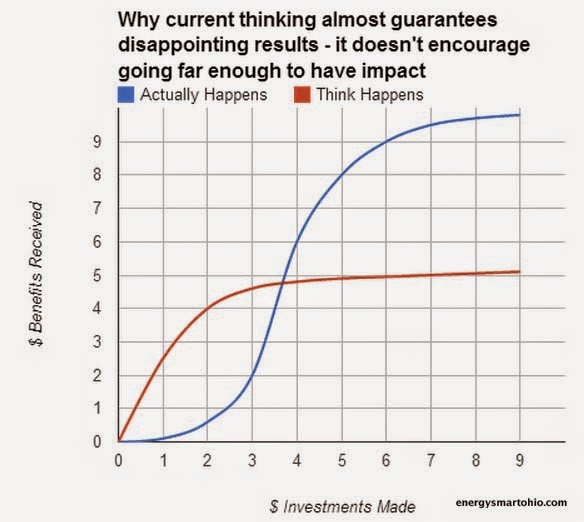
Low Hanging Fruit: A Major Cause Behind Poor Realization Rates
See the problem? Red “Low Hanging Fruit” thinking causes investment to stop well before Blue goes vertical. It’s a much easier sale, it can be made in one visit. Contractor and program walk away happy – claiming the red “win”, except the consumer is left to experience the blue outcome. The truth of this is supported by both low average project job size, and the fact that these programs’ own M&V studies show dismal realization rates.
The consumer’s side of this problem is high likelihood of disappointment. Expectations are high, and outcomes are poor. This is illustrated by what we call “The Gulf of Disappointment”

By educating about this risk smart consumers chose to avoid it. The easy answer is go deeper. Go deep enough that performance of the house is significantly altered and brought into balance. Go beyond the convergence of red and blue – reach even beyond the point of diminishing returns to insure great outcomes. Go deep enough to deliver outcomes that exceed expectations and live life in the “Sea of Success”.

Otherwise, why bother? The Home Performance exercise requires a lot of diagnostics and planning. It’s a fair amount of effort. Why bother if you aren’t going deep enough to remove risk of disappointing outcomes? Of not solving occupant problems and frustrations. Why bother if you aren’t going to shrink the energy footprint?
Typically our jobs are 3 to 4 times the size of most program jobs. Our jobs are more comprehensive, project savings with much higher precision, and most importantly they result in happy consumers. Programs would be better if they encouraged results like this.
Conclusion
Market transformation requires happy consumers. It requires people get what they paid for, not half measures delivering quarter results. If the HP industry continues to chase low hanging fruit, we are unlikely to achieve those remarkable results and market transformation.
Coming Up
There are some hard truths as in industry we need to accept before breakthrough is possible.
Then we discuss the actual One Knob program that creates reward for doing the hard work of being thorough. A program that rewards going deeper, that tracks results and ranks contractors based upon their ability to deliver. A simple program that everyone will want to participate in. A program that is capable of market transformation.

Want to Help?
1. Share the heck out of this! Comment! Like! Make noise! Nothing is going to change unless we push for it.
2. Go join the Linked In ‘Get Energy Smart’ group. We’re going to need help making enough noise to get things changed, please add your voice! We’ll update you with action steps there as well.
3. Connect with me on Linked In and mention One Knob. Feel free to email me at nate@energysmartohio.com.
Further Reading for Pros:
One Knob Part 1 – Goals – Results Focus, Accountability, and Market Transformation
One Knob Part 2 – Fallacy of Low Hanging Fruit
One Knob Part 3 – Hard Truths of Home Performance
One Knob Part 4 – Program Design Summary
How an Efficiency Program Killed My Business, Part 1
How an Efficiency Program Killed My Business, Part 2
Confessions of an Insulation Contractor, Part 1
Confessions of an Insulation Contractor, Part 2
The Science Behind Home Performance
True Comfort is Indoor Environmental Quality (IEQ)
Case Study of an Insulation Failure
Post Script
These ideas are frankly not my own, they are largely a repackaging. I stood on the shoulders of giants to put all this together. Thanks to Rick Gerardi, Rick Chitwood, Lew Harriman, Mike MacFarland, Matt Golden, Andy Frank, and many, many more for supplying pieces to the puzzle.
Acknowledgements:
This series has been the toughest thing I have ever written. It has the potential to truly change the world. There is no way I could have done it alone, I am thankful for having tons of help, thoughtful commentary, constructive criticism, support, clarifications of my crummy writing, keeping me out of arguments I don’t want to get involved in (political, mostly), incredibly helpful changes that strengthened weak parts of the argument, and just generally showing me love by taking the time to really read. Help came from inside and outside the HP industry. Here is a list of those lovely folks, in no particular order. If I missed anyone, it’s my fault!
Chris Dorsi
Griffin Hagle
Michael Panetta
Greg Jones
Val Lumby
Stephen Lacey
Gary Wood
Andy Frank
Larry Janesky
Carrie Coxwell
David Butler
Robert Bean
Bill Spohn
John Craig
Image Attribution: Volume Knob Baby Pacifier by Fred sold on BaronBob.com Did you notice it goes to 11?
Image Attribution: Rosie the Riveter Creative Commons
Get the HVAC Guide

It's free! Make buying a new furnace, air conditioner, or heat pump less stressful.





